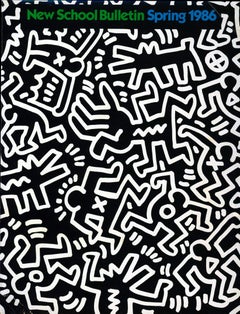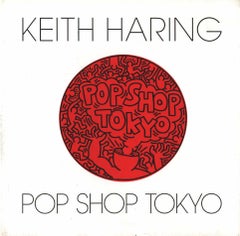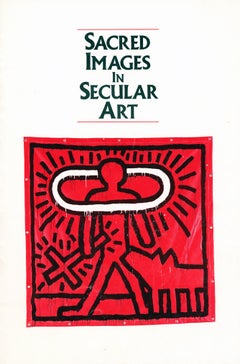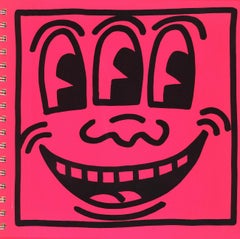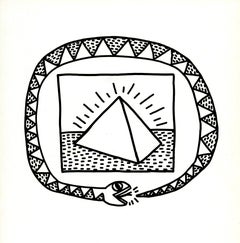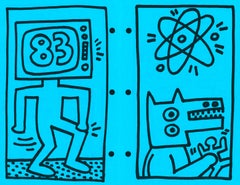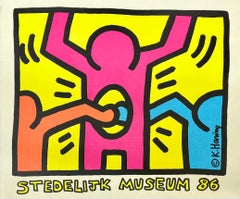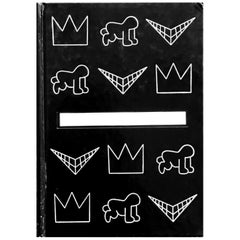Keith Haring Catalog
1980s Pop Art Prints and Multiples
Paper
1980s Pop Art Prints and Multiples
Paper
1980s Pop Art Prints and Multiples
Paper
1980s Pop Art Prints and Multiples
Paper
1980s Pop Art Prints and Multiples
Metal
1980s Contemporary Animal Prints
Paper, Offset
1980s Pop Art Figurative Prints
Lithograph, Offset
1980s Pop Art Prints and Multiples
Paper
1990s Pop Art Prints and Multiples
Offset
1980s Pop Art Figurative Prints
Lithograph, Offset
1980s Pop Art Prints and Multiples
Lithograph, Offset
1980s Pop Art Prints and Multiples
Paper, Ink
1980s Pop Art Figurative Prints
Lithograph, Offset
1980s Pop Art Prints and Multiples
Lithograph, Offset
1980s Pop Art Animal Prints
Lithograph, Offset
1980s Pop Art Animal Prints
Offset, Lithograph
1980s Pop Art Prints and Multiples
Offset, Paper
1980s Pop Art Prints and Multiples
Offset
1980s Pop Art Figurative Paintings
Magazine Paper, Permanent Marker
1980s Street Art More Art
Lithograph, Offset, Paper
1980s Pop Art Abstract Prints
Lithograph, Offset
1980s Pop Art Prints and Multiples
Paper
1980s Pop Art Prints and Multiples
Lithograph, Offset
1980s Pop Art Prints and Multiples
Offset
1980s Pop Art Prints and Multiples
Paper
1980s Pop Art Figurative Prints
Offset, Lithograph
1980s Pop Art Figurative Prints
Offset, Lithograph
1980s Pop Art Figurative Prints
Lithograph, Offset
1980s Pop Art Figurative Prints
Lithograph, Offset
1980s Pop Art Figurative Drawings and Watercolors
Ink, Paper
1980s Pop Art Figurative Prints
Offset, Lithograph
1980s Pop Art Figurative Prints
Lithograph
1980s Pop Art Figurative Prints
Lithograph, Offset
1980s Pop Art Figurative Prints
Lithograph, Offset
1980s Pop Art Figurative Prints
Lithograph
1980s Pop Art Figurative Prints
Screen
1980s Pop Art Animal Prints
Lithograph, Offset
1980s Pop Art Figurative Prints
Lithograph, Offset
1980s Pop Art Figurative Prints
Lithograph, Offset
1980s Pop Art Figurative Prints
Lithograph, Offset
1980s Pop Art Figurative Prints
Lithograph, Offset
1980s Pop Art Prints and Multiples
Offset
1980s Pop Art Prints and Multiples
Lithograph, Offset
1980s Pop Art Prints and Multiples
Lithograph, Offset
1990s Pop Art Prints and Multiples
Offset, Paper, Lithograph
1980s Pop Art More Art
Paper, Lithograph, Offset
1980s Pop Art Prints and Multiples
Lithograph
Early 2000s Street Art Prints and Multiples
Paper
1980s Pop Art Prints and Multiples
Paper
1980s Pop Art Prints and Multiples
Paper
1980s Pop Art Prints and Multiples
Paper
1980s Pop Art More Art
Offset
1980s Pop Art More Art
Offset
1980s Pop Art More Art
Paper
1980s Pop Art Prints and Multiples
Offset
1980s Pop Art Figurative Prints
Lithograph, Offset
1980s Pop Art Figurative Prints
Lithograph
1980s Pop Art Figurative Prints
Screen
1980s Pop Art Figurative Prints
Screen
1980s Pop Art Figurative Prints
Screen
- 1
Keith Haring Catalog For Sale on 1stDibs
How Much is a Keith Haring Catalog?
A Close Look at Pop Art Art
Perhaps one of the most influential contemporary art movements, Pop art emerged in the 1950s. In stark contrast to traditional artistic practice, its practitioners drew on imagery from popular culture — comic books, advertising, product packaging and other commercial media — to create original Pop art paintings, prints and sculptures that celebrated ordinary life in the most literal way.
ORIGINS OF POP ART
- Started in Britain in the 1950s, flourished in 1960s-era America
- “This is Tomorrow,” at London's Whitechapel Gallery in 1956, was reportedly the first Pop art exhibition
- A reaction to postwar mass consumerism
- Transitioning away from Abstract Expressionism
- Informed by neo-Dada and artists such as Jasper Johns and Robert Rauschenberg; influenced postmodernism and Photorealism
CHARACTERISTICS OF POP ART
- Bold imagery
- Bright, vivid colors
- Straightforward concepts
- Engagement with popular culture
- Incorporation of everyday objects from advertisements, cartoons, comic books and other popular mass media
POP ARTISTS TO KNOW
- Richard Hamilton
- Andy Warhol
- Marta Minujín
- Claes Oldenburg
- Eduardo Paolozzi
- Rosalyn Drexler
- James Rosenquist
- Peter Blake
- Roy Lichtenstein
ORIGINAL POP ART ON 1STDIBS
The Pop art movement started in the United Kingdom as a reaction, both positive and critical, to the period’s consumerism. Its goal was to put popular culture on the same level as so-called high culture.
Richard Hamilton’s 1956 collage Just what is it that makes today’s homes so different, so appealing? is widely believed to have kickstarted this unconventional new style.
Pop art works are distinguished by their bold imagery, bright colors and seemingly commonplace subject matter. Practitioners sought to challenge the status quo, breaking with the perceived elitism of the previously dominant Abstract Expressionism and making statements about current events. Other key characteristics of Pop art include appropriation of imagery and techniques from popular and commercial culture; use of different media and formats; repetition in imagery and iconography; incorporation of mundane objects from advertisements, cartoons and other popular media; hard edges; and ironic and witty treatment of subject matter.
Although British artists launched the movement, they were soon overshadowed by their American counterparts. Pop art is perhaps most closely identified with American Pop artist Andy Warhol, whose clever appropriation of motifs and images helped to transform the artistic style into a lifestyle. Most of the best-known American artists associated with Pop art started in commercial art (Warhol made whimsical drawings as a hobby during his early years as a commercial illustrator), a background that helped them in merging high and popular culture.
Roy Lichtenstein was another prominent Pop artist that was active in the United States. Much like Warhol, Lichtenstein drew his subjects from print media, particularly comic strips, producing paintings and sculptures characterized by primary colors, bold outlines and halftone dots, elements appropriated from commercial printing. Recontextualizing a lowbrow image by importing it into a fine-art context was a trademark of his style. Neo-Pop artists like Jeff Koons and Takashi Murakami further blurred the line between art and popular culture.
Pop art rose to prominence largely through the work of a handful of men creating works that were unemotional and distanced — in other words, stereotypically masculine. However, there were many important female Pop artists, such as Rosalyn Drexler, whose significant contributions to the movement are recognized today. Best known for her work as a playwright and novelist, Drexler also created paintings and collages embodying Pop art themes and stylistic features.
Read more about the history of Pop art and the style’s famous artists, and browse the collection of original Pop art paintings, prints, photography and other works for sale on 1stDibs.
- Where is Keith Haring from?1 Answer1stDibs ExpertMarch 22, 2022Keith Haring is originally from Kutztown, Pennsylvania, although he was born in the nearby city of Reading, Pennsylvania, on May 4, 1958. In 1978, Haring moved to New York City. He continued to live there until he died on February 16, 1990. Find a selection of Keith Haring art on 1stDibs.
- Who is Keith Haring?1 Answer1stDibs ExpertMarch 22, 2022Keith Haring was a modern American artist and activist. He began as a street artist creating graffiti-inspired works throughout New York City’s subway system and would later produce public murals in cities all over the world. Haring’s paintings, prints and murals address the universal themes of death, love and sex, as well as contemporary issues he experienced personally, like the crack-cocaine and AIDS epidemics. In 1986, Haring opened a Pop Shop in Manhattan’s Soho neighborhood to sell merchandise bearing his bold, cartoon-inspired designs. On 1stDibs, find a variety of Keith Haring art.
- What is Keith Haring famous for?1 Answer1stDibs ExpertMarch 22, 2022Keith Haring is famous for producing bold cartoon-style art. You may see his work printed on everything from home décor to coffee mugs to fashion accessories. He gained notoriety for street art in his early days as an artist. Later, Haring’s revered paintings, prints and murals would address the universal themes of death, love and sex, as well as contemporary issues he experienced personally, like the crack-cocaine and AIDS epidemics. On 1stDibs, find a collection of Keith Haring art.
- 1stDibs ExpertMarch 25, 2024Keith Haring's art was about a variety of subjects. His paintings, prints and murals addressed themes of death, love and sex, as well as contemporary issues, like drug use and the AIDS epidemic. His work derives much of its impact from the powerful contrast between these serious subjects and the joyful, vibrant pictographic language he used to express them. Haring’s enduring work is full of dancing figures, babies, barking dogs, hearts and rhythmic lines, as well as references to pop culture. On 1stDibs, explore a collection of Keith Haring art.
- How do I pronounce Keith Haring?1 Answer1stDibs ExpertMarch 22, 2022To pronounce Keith Haring, say "Keeth HEH-ring." Keith Haring was born on May 4, 1958, in Reading, Pennsylvania, and grew up in nearby Kutztown, Pennsylvania. You'll find a range of Keith Haring art on 1stDibs.
- Where did Keith Haring work?1 Answer1stDibs ExpertMarch 22, 2022In his early days as an artist, Keith Haring worked primarily in New York City, where he created murals on walls and unused advertising boards along Manhattan’s subway system. Once his work gained popularity, he traveled to produce work in Australia, Europe and elsewhere. You'll find a collection of Keith Haring art on 1stDibs.
- 1stDibs ExpertMarch 22, 2022The Keith Haring Foundation is a philanthropic organization founded by the artist Keith Haring in 1989. Its mission is to provide funding for nonprofit organizations who offer services and programs for children or conduct research or educational initiatives related to AIDS.
- Where did Keith Haring live?1 Answer1stDibs ExpertMarch 22, 2022For most of his life, Keith Haring lived in New York City and died there on February 16, 1990. He grew up in Kutztown, Pennsylvania, and briefly attended an art school in Pittsburgh, Pennsylvania. After he arrived in New York in 1978, he turned the city into a gallery space, creating murals in public areas like subway stations. On 1stDibs, shop a collection of Keith Haring art.
- What was Keith Haring known for?1 Answer1stDibs ExpertAugust 8, 2024Keith Haring was known for his work as an artist. He began experimenting with his bold, graphic lines and cartoon-inspired figures on the walls of New York City subway stations in the early 1980s. He called these underground places his “laboratory” to develop a radical new aesthetic based on the ideology of creating truly democratic public art. Haring used paintings, prints and murals to address the universal themes of death, love and sex, as well as contemporary issues he experienced personally, like the crack-cocaine and AIDS epidemics. These works derive much of their impact from the powerful contrast between these serious subjects and the joyful, vibrant pictographic language he used to express them, full of dancing figures, babies, barking dogs, hearts and rhythmic lines, as well as references to pop culture. To make his art even more accessible, in 1986, Haring opened the Pop Shop in Soho. In a foreshadowing of today’s intermingling of art and fashion, the shop sold merchandise and novelty items featuring his imagery. Find a collection of Keith Haring art on 1stDibs.
- 1stDibs ExpertFebruary 1, 2024Some facts about Keith Haring include that he began his career by creating street art in New York subway stations, which he referred to as his "laboratory." In 1986, Haring opened the Pop Shop in Manhattan’s Soho neighborhood and began selling merchandise and novelty items featuring imagery by himself and contemporaries like Kenny Scharf and Jean-Michel Basquiat. Also, the world's largest jigsaw puzzle features Haring's artwork and consists of 32,000 pieces. After his death, his estate formed the Keith Haring Foundation to raise awareness about AIDS and fund research into the autoimmune disease. On 1stDibs, explore a wide range of Keith Haring art.
- When was Keith Haring born?1 Answer1stDibs ExpertMarch 22, 2022Keith Haring was born on May 4, 1958, in Reading, Pennsylvania. After growing up in Kutztown, Pennsylvania, and briefly attending art school in Pittsburgh, Pennsylvania, he moved to New York City, where he made a name for himself creating street art on the subway system. Haring gained an even larger audience in the years that followed, producing public murals that were often commissioned and making art that was frequently informed by political and cultural issues. On 1stDibs, find a selection of Keith Haring art.
- Why is Keith Haring important?1 Answer1stDibs ExpertMarch 22, 2022Keith Haring is important primarily because his innovative work, which began as street art on the New York City subway, became widely known during the 1980s and influenced other artists working at the time. Haring was also an activist — his late-career prints and murals addressed contemporary issues he experienced personally, like the crack-cocaine and AIDS epidemics. Haring helped elevate graffiti art and was one of the first artists to begin placing his designs on merchandise sold to the general public through his Pop Shop in New York City. Shop a collection of Keith Haring art on 1stDibs.
- What inspired Keith Haring?1 Answer1stDibs ExpertMarch 22, 2022Keith Haring drew most of his inspiration from graffiti artists and got his start painting subway stations and other locations around New York City. In addition, artists such as Pierre Alechinsky, William Burroughs, Jean Dubuffet, Brion Gysin and Robert Henri influenced his work. On 1stDibs, shop a collection of Keith Haring art.
- 1stDibs ExpertApril 5, 2022The Keith Haring Foundation owns international copyright to artwork created by Keith Haring. In 1989, Haring himself established the foundation to ensure that his philanthropic legacy would continue. The Keith Haring Foundation today makes grants to charitable activities in accordance with Haring’s wishes. Shop a selection of Keith Haring pieces from some of the world’s top art dealers on 1stDibs.
- 1stDibs ExpertAugust 20, 2024How much a Keith Haring painting is worth depends on its history, age, size and other factors. In 2017, his 1982 Untitled sold for more than $6.5 million at an auction in New York. Many of Haring’s paintings, prints and murals address the universal themes of death, love and sex, as well as contemporary issues like the crack cocaine and AIDS epidemics. They derive much of their impact from the powerful contrast between these serious subjects and the joyful, vibrant pictographic language he used to express them, full of dancing figures, babies, barking dogs, hearts and rhythmic lines, as well as references to pop culture. If you have a Haring piece, a certified appraiser or experienced art dealer can give you an idea of how much it may be worth. On 1stDibs, shop a range of Keith Haring art.
- 1stDibs ExpertMarch 22, 2022For his earlier works of art, Keith Haring found inspiration in graffiti and applied paint or chalk to advertising boards spread across New York City that had not yet been used. Much of Haring’s street art was created in subway stations. As his work became more widely known, Haring was frequently commissioned for public murals and would often paint in oils and acrylics on canvas. He also produced merchandise bearing some of his most famous designs. Shop a selection of Keith Haring art on 1stDibs.
- 1stDibs ExpertApril 5, 2022There are a few tell-tale signs you can look for to determine whether your Keith Haring is real or fake. Authentic Keith Haring artwork features a continuous, unbroken line, a subtle signature, barking dogs and crying babies. There are often fakes and the story of them being a gift to an old boyfriend is often an invalid provenance. Shop a collection of authentic Keith Haring artwork from some of the world’s top art dealers on 1stDibs.
- 1stDibs ExpertMarch 22, 2022You can buy Keith Haring art from a variety of sources. One option is to go through an auction house or reputable art dealer. Some trusted online platforms also sell pieces by Keith Haring. You'll find a collection of expertly vetted Keith Haring art on 1stDibs.
- 1stDibs ExpertFebruary 27, 2024The Keith Haring Foundation owns the Keith Haring estate. In 1989, the American artist set up the foundation to guarantee that his philanthropic efforts would continue after his death. Under the foundation's structure, The Keith Haring Studio is the owner of the copyrights to all of Haring's works. Find an assortment of Keith Haring art on 1stDibs.
- 1stDibs ExpertApril 11, 2024Keith Haring worked in a variety of mediums. The legendary Pennsylvania-born artist experimented with painting, sculpture, printmaking, performance, video, murals and more. In 2023, a series of digital drawings Haring made on a personal computer during the late 1980s went to auction. No canvas was off limits, either, as he painted on wood, vast tarps and sheets of metal. Haring was always experimenting, even in his early days as an artist.
When Haring arrived in New York City, he was drawn to subway graffiti and other street art, and was soon drawing with chalk on the black sheets of paper that were affixed to subway panels when there wasn’t a poster advertisement to populate the space.
To make his art even more accessible, in 1986, Haring opened the Pop Shop in Soho. In a foreshadowing of today’s intermingling of art and fashion, the shop sold merchandise and novelty items featuring imagery by Haring and contemporaries like Kenny Scharf and Jean-Michel Basquiat.
Find original Keith Haring art on 1stDibs.
Read More
10 Reasons Art Collectors Are Obsessed with Andy Warhol
More than three decades after his death, the prolific Pop artist and cultural icon's body of work continues to captivate. Here's a primer of some of his most notable motifs and mediums.
Exploring Our Current Obsession with Sixties Style
A new exhibition in Philadelphia stars a complex decade that continues to inspire.

